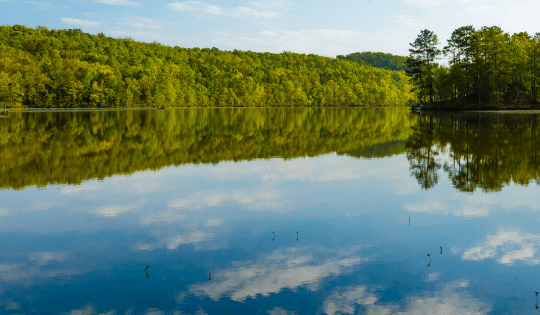While some die-hard outdoor enthusiasts opt to camp year-round, others prefer to wait until the days are a little longer and the temperature is a little warmer. Spring in Alabama is the perfect time to hit the trails and pitch a tent, as the trees are budding and the wildflowers are starting to bloom, but the bugs and humidity have yet to make their annual return. Here are five popular — and unique — camping opportunities in the Yellowhammer State.
Located atop Lookout Mountain in northeast Alabama, the 3,500-acre DeSoto State Park features waterfalls, wildflower fields, and plenty of rustic beauty. Nearby sites of interest include the Little River Canyon Preserve, the 104-foot Desoto Falls, and the Walls of Jerico Forever Wild Tract.
Accommodations
The park offers an improved campground with 94 full-hookup tent and RV sites, primitive camping sites for tents, and two backcountry campsites with shelters.
Recreation & Attractions
You can find something for everyone at DeSoto. Recreational activities include kayaking, biking, cycling, bouldering, rappelling, hiking, fishing, and wildflower expeditions. The historic park also has a picnic area and an ADA-accessible boardwalk trail.
The park is free. Pets and fires are allowed. Reservations can be made online.

Cheaha is the oldest, continuously operating state park in Alabama. It’s also home to the state’s highest point, Cheaha Mountain, which is 2,407 feet above sea level. The park features amazing views to appreciate beautiful sunsets as well as some spectacular waterfalls.
Accommodations
The park boasts five campgrounds: two developed, one semi-primitive, one primitive, and a group campground. The developed campgrounds feature RV hookups.
Recreation & Attractions
Nestled in the Talladega National Forest, Cheaha offers endless opportunities for outdoor exploration. It’s home to the Cheaha Trailhead of the Pinhoti Trail, which connects to the Appalachian Trail, the Odum Scout Trail, and the Chinnabee Silent Trail. Cheaha also includes access to the Kentuck ORV-ATV trail.
Park fees are: Age 0-3 free, 4-11 $2, 12 and older $5, Seniors 62+ $2, Veterans and Active Military (with ID) enter for free. Annual passes are $55 for seniors/disabled, $105 for individuals 12 and older and $155 for a family of up to six. Fires and pets are allowed. Reservations can be made online.
Deerlick Creek is a shoreline located on Holt Lake that was created by damning the Black Warrior River. The creek and river connect to the Tom Bigbee Waterway, which includes six lakes with a total length of 457 miles and nearly 40,000 surface acres of water. The shoreline campground is nestled in a hardwood and pine forest, where plenty of turkey, deer, migratory birds, and bluebirds live.
Accommodations
Forty-six campsites include electric and water hookups and access to showers, while six of the sites are tent-only. In addition, the campground features a picnic shelter that can be reserved, a mixed-use court, and a swimming beach.
Recreation & Attractions
Watersports and fishing opportunities are abundant at Deerlick Creek. The waterway is populated with bass, crappie, bream, catfish and more. Boating and swimming are popular, and the area has numerous hiking trails and a paved bike trail.
Nightly fees range from $20-$30. Pets and fires are allowed. You can check site availability online.
Enjoy two miles of sandy white beaches and crystal-clear salt water as well as Lake Shelby, a 900-acre freshwater lake. The park’s 6,500 sun-drenched acres provide ample opportunity for everyone to enjoy their outdoor passion.
Accommodations
There’s lots of room and all kinds of camping with a 496-site improved campground that features pull-through and back-in sites, waterfront sites, and ADA-accessible sites. Paved pads provide full hookups, and the park also features three new “glamping” sites and 11 primitive camping sites. You’ll find picnic tables throughout the park.
Recreation & Attractions
Obviously, popular activities include boating, fishing, swimming, kayaking, canoeing, paddling, and even parasailing are popular choices. It also features hiking and biking trails, a wildflower and butterfly garden, and much more.
But keep in mind that Gulf State Park is home to many types of wildlife, including alligators. Please be aware at all times and respectful.
The free park allows fires and dogs. You can make camping reservations online.
The 250,000-acre Mobile-Tensaw Delta is the second largest river delta in the United States. It’s a vast wetland of marshes, swamps and bottomland hardwood ecosystems and home to more than 50 endangered animal and plant species. It’s also where you’ll find the Bartram Canoe Trails, one of the longest aquatic trails in the country. Bartram Canoe Trails features six day-use trails and six overnight trails, which take canoeists, kayakers and recreational boaters through miles of rivers, streams, lakes, sloughs, and bayous.
Accommodations
The trail system features two primitive land-based campsites, which are open to anyone on a first-come, first-served basis. Along the upper trail overnight route, you will find four floating platform campsites. Meanwhile, the lower trail overnight routes have four elevated camping shelters. Only canoeists and kayakers can reserve the floating platforms and elevated camping shelters.
Recreation & Attractions
Obviously, canoeing, kayaking, and boating are the primary means of exploring the 170+ miles of trails through the delta. Bartram allows fishing. However, the trail system discourages swimming due to the local alligator populations.
You can reserve the water-based campsites online for a $26.50 fee. Fires are allowed in the land-based campsites only. No pets are allowed.
We want everyone to enjoy the outdoors, and we work to build loyalty one connection at a time. Visit our online store and take advantage of guaranteed 24-hour shipment or curbside delivery! #BeOutdoors
 We found five ways to help you appreciate nature without leaving your home:
We found five ways to help you appreciate nature without leaving your home: You also can broaden you and your family’s horizon by going on a virtual tour of a zoo or aquarium! Apartment Therapy released a list of some of the top zoos and aquariums offering up-close tours and live streaming. You can emulate the sloth in your own natural habitat while gazing into the deep blue of the Georgia Aquarium.
You also can broaden you and your family’s horizon by going on a virtual tour of a zoo or aquarium! Apartment Therapy released a list of some of the top zoos and aquariums offering up-close tours and live streaming. You can emulate the sloth in your own natural habitat while gazing into the deep blue of the Georgia Aquarium.  Unplugging in nature feels like the ultimate carefree adventure, but we still need to do our part to keep public lands beautiful and wild.
Unplugging in nature feels like the ultimate carefree adventure, but we still need to do our part to keep public lands beautiful and wild. We all love sharing beautiful places with the ones we love. But instead of trampling native plants to get the perfect shot on
We all love sharing beautiful places with the ones we love. But instead of trampling native plants to get the perfect shot on Are you a first-time camper or do you just want to enjoy something easy and fun at home?
Are you a first-time camper or do you just want to enjoy something easy and fun at home?  “Hiking and happiness go hand in hand or foot in boot,” says outdoors author Diane Spicer. It is no secret that time spent outdoors lowers stress levels, improves your mood, and provides other great health benefits.
“Hiking and happiness go hand in hand or foot in boot,” says outdoors author Diane Spicer. It is no secret that time spent outdoors lowers stress levels, improves your mood, and provides other great health benefits.  We already love the benefits of yoga and being outdoors. What better idea than to practice your tree pose among the trees? The serenity of the outdoors will help you focus on your breathing and
We already love the benefits of yoga and being outdoors. What better idea than to practice your tree pose among the trees? The serenity of the outdoors will help you focus on your breathing and  So invest in a cozy
So invest in a cozy  Try walking in the rain, without worrying about whether you get soaked. Wear your rain gear and just listen to the rain, notice how it puddles, how green the trees and grass look thanks to the showers. Be mindful of the moment. Soak it up ( pun intended.)
Try walking in the rain, without worrying about whether you get soaked. Wear your rain gear and just listen to the rain, notice how it puddles, how green the trees and grass look thanks to the showers. Be mindful of the moment. Soak it up ( pun intended.) In essence, instead of the breath, you are using your steps as an anchor to stay present in the moment. Of course, you can do this at any time during your hike, but often I prefer to be a bit more intentional.
In essence, instead of the breath, you are using your steps as an anchor to stay present in the moment. Of course, you can do this at any time during your hike, but often I prefer to be a bit more intentional. As always, it’s important to check official websites in your community for specific guidelines. Nevertheless, fresh air and movement are important for your mental, physical, and emotional health. So we put together some ideas to keep your family active, engaged, and outdoors as much as possible!
As always, it’s important to check official websites in your community for specific guidelines. Nevertheless, fresh air and movement are important for your mental, physical, and emotional health. So we put together some ideas to keep your family active, engaged, and outdoors as much as possible! you’ll need to keep them on a leash. The trail can be rocky, wet and has blowdowns, so choose
you’ll need to keep them on a leash. The trail can be rocky, wet and has blowdowns, so choose 